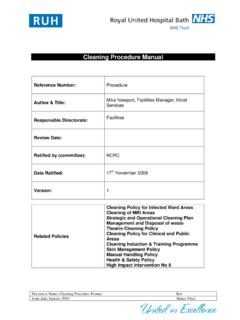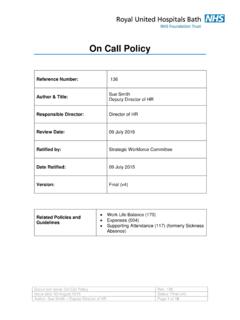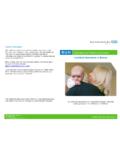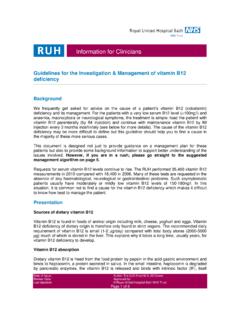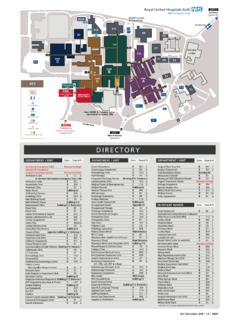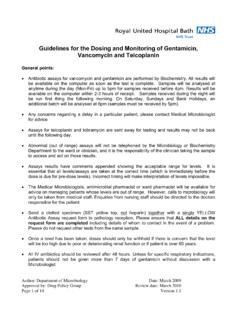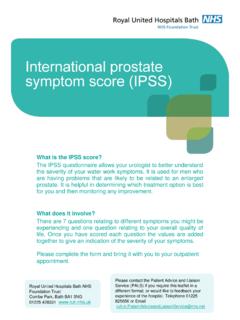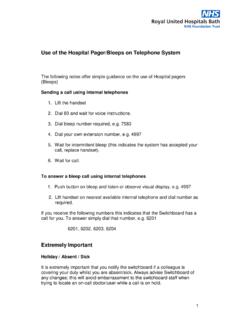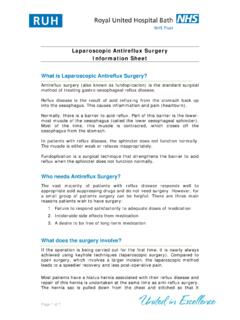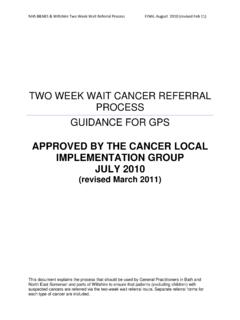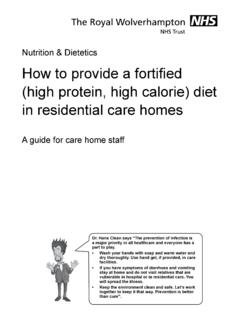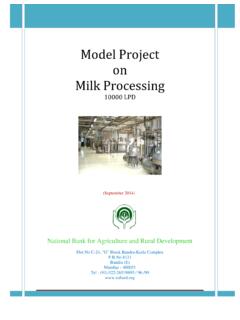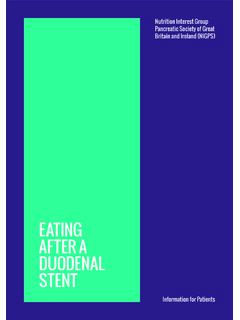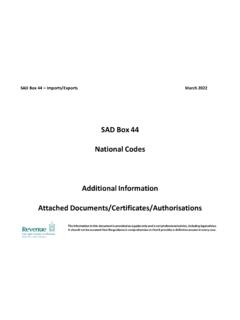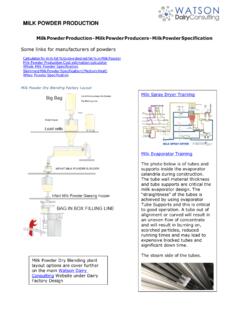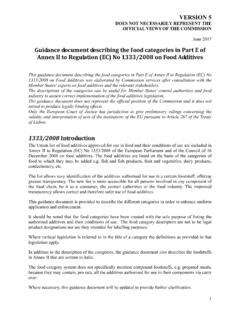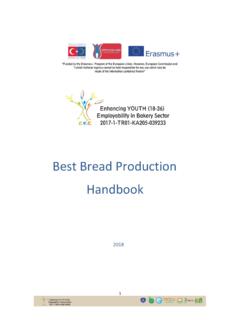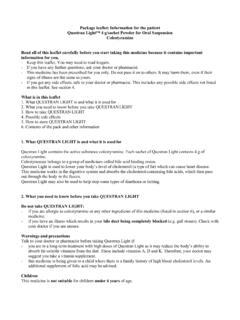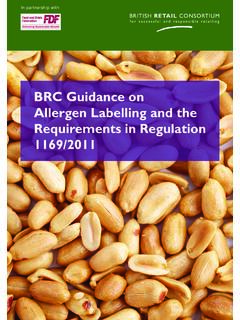Transcription of Food first advice for improving ... - Royal United Hospital
1 food first advice for improving nutrition At times some people need extra nourishment. This can be achieved by adding more fat and sugar into your diet than would normally be advised, as well as eating enough protein within a good variety of foods. This can help you put on weight, feel stronger, fight infection, improve wound healing or cope better with any treatment. Some ideas to help improve your appetite and make the most of your food and fluid Small frequent meals and snacks are a good way to increase your calorie intake, aim to eat every 2-3 hours. Fortifying your diet will help to make a small amount of food or drink more nourishing.
2 Eat a wide variety of foods to help you get all the nutrition that your body needs. Include nourishing drinks and/or nourishing snacks between meals. Avoid drinking before meals as this can make you feel full, try taking drinks with or after meals but still aim to drink 6-8 cups/glasses of fluid a day. Make these drinks as nourishing as possible. Use whole milk (full fat). If you find preparing meals tiring, make use of frozen or ready-made meals and snacks. Try to get outside for some fresh air before meal times if possible. Vitamins and Minerals It is a good idea to take a one a day' A-Z multivitamin and mineral tablet whilst you have a poor appetite as you may be deficient in some nutrients.
3 This can be purchased in a Supermarket, high street retailer or a pharmacy and should not be expensive. Please consult your GP if you are unsure if vitamins or minerals have already been prescribed. It is important not to double up on vitamin and mineral tablets. food first advice for improving nutrition food Fortification Try simple ways to increase the energy and protein content of meals. Initially aim to fortify one dish per meal. Oil, butter and Add butter or full fat spread to potatoes and vegetables. margarine Drizzle olive oil on pasta. Oven roast potatoes and vegetables in oil.
4 Thickly spread butter or full fat spread on bread and toast. Cheese Grate cheese and sprinkle on top of meals, beans on toast, spaghetti bolognaise, soup. Include in sandwiches and add to mashed potatoes. Mayonnaise, Include in sandwiches. salad cream Add to salads, chips or baked potatoes. and dressings Have coleslaw, or other mayonnaise dressed salads as a portion of vegetables. milk , Cream and Add cream to soups, yoghurts, desserts, hot drinks. Ice cream Make custard and milk based pudding with 1/3 cream and 2. /3 milk . Mash milk or cream into potatoes. Sauces are useful to make meals more palatable and nourishing.
5 Try making milky or creamy sauces with fortified milk and flavour with cheese or herbs and serve with pasta, potato, vegetables, meat and fish. Serve evaporated or condensed milk with fruit or jelly. Lentils, pearl Add lentils, pearl barley or mini pasta shapes to soup, barley and mini casseroles or stews. pasta shapes Sugar, Honey, Use in hot drinks and hot puddings pie crumble or Syrup milk based puddings. Add to porridge and breakfast cereals. Drink fizzy drinks and cordials that contain sugar. (use sparingly, if at all, if you have Diabetes). Chocolate, nuts, Add grated chocolate, chopped nuts or dried fruit to hot dried fruit and puddings, cold desserts, cereals or porridge.
6 Marshmallows Sprinkle chocolate or marshmallows on hot drinks. Date of publication 04/20 Review 04/23. Ref: RUH FoodFirst/014 Royal United Hospitals Bath NHS Foundation Trust Page 2 of 7. food first advice for improving nutrition Nourishing Drinks Aim for two nourishing drinks per day to help prevent weight loss and encourage weight gain. Have nourishing drinks in between your meals, not in place of a meal! Choose full fat and full sugar products rather than diet', sugar free' or skimmed' varieties as these provide more calories. Use milk , dairy-free milk alternatives ( soya rather than nut milk as this has more calories and protein) or fruit juice as base ingredients in your drinks rather than water.
7 Relax with a warm milky drink such as Horlicks , Ovaltine or drinking chocolate before bed. Make fortified milk to boost protein and calorie content. Add 5 tablespoons of dried milk powder to 1 pint of milk , stir until dissolved and use like regular milk . Marvel or supermarket-own brands are available. Try the following recipes: Blend all the recipes below until smooth. Each recipe below makes 1 serving. Basic Homemade Milkshake recipe Malted Honey Drink 170ml full fat milk 200ml full fat milk 2 tablespoon double cream 4 teaspoons Ovaltine or Horlicks powder 1 tablespoon dried milk powder 1 scoop ice cream 1 tablespoon Nesquik/milkshake powder 1 tablespoon honey or sugar Per serving approx.
8 360kcal, 13g protein Per serving approx. 310kcal, 10g protein Banutty Smoothie Fruit Blast 150ml full fat milk 100ml fresh fruit juice 1 scoop ice-cream 100ml lemonade (not sugar free). 1 tablespoon dried milk powder 1 scoop ice-cream (can be dairy free). banana 1 tablespoon sunflower or vegetable oil 1 tablespoon smooth peanut butter 2 heaped teaspoons sugar 1 tablespoon sugar or honey Per serving approx. 300kcal (minimal Per serving approx. 420kcal, 17g protein protein). Date of publication 04/20 Review 04/23. Ref: RUH FoodFirst/014 Royal United Hospitals Bath NHS Foundation Trust Page 3 of 7.
9 food first advice for improving nutrition Nourishing Snacks Try eating one nourishing snack between meals ( mid-morning, mid-afternoon, before bed). Sweet Options Milky puddings (rice pudding, tapioca, custard, mousse). Yoghurt (not low fat), individual trifle or mousse. Chocolate, biscuits, cakes, pastries. Breakfast cereal (with fortified milk ) or cereal bars. Tea cake, tea bread, malt loaf with butter/spread and jam or scone with jam and cream. Croissants and waffles. Dried fruit or fruit and nut mix. Savoury Options Cheese, pate or hummus with crackers, bread sticks or biscuits.
10 Crisps, nuts, Bombay mix. Pork pie, sausage roll, scotch eggs, cocktail sausages, slices of pizza or quiche. Pasties and samosas. Toast, crumpets or muffins with butter or spread. Peanut butter on toast, cheese on toast, beans on toast. Ham or cheese sandwiches. Cheese with pineapple or sliced apple. Meal ideas Breakfast Porridge with whole or fortified milk and cream. Swiss style, or crunchy muesli cereals with yoghurt (not low fat) and fresh fruit. Croissant, waffles, crumpet, bread or toast with butter or spread and jam, chocolate spread, marmalade, peanut butter or cheese spread.
